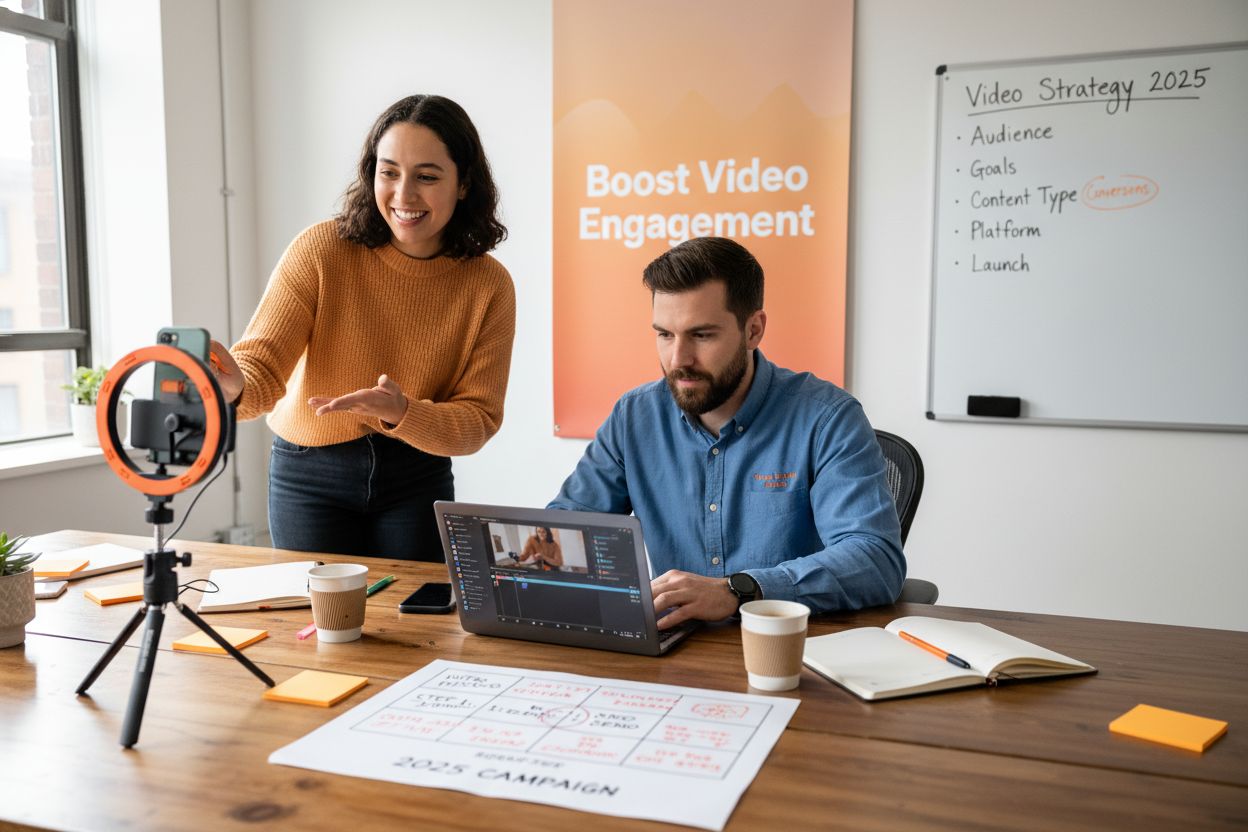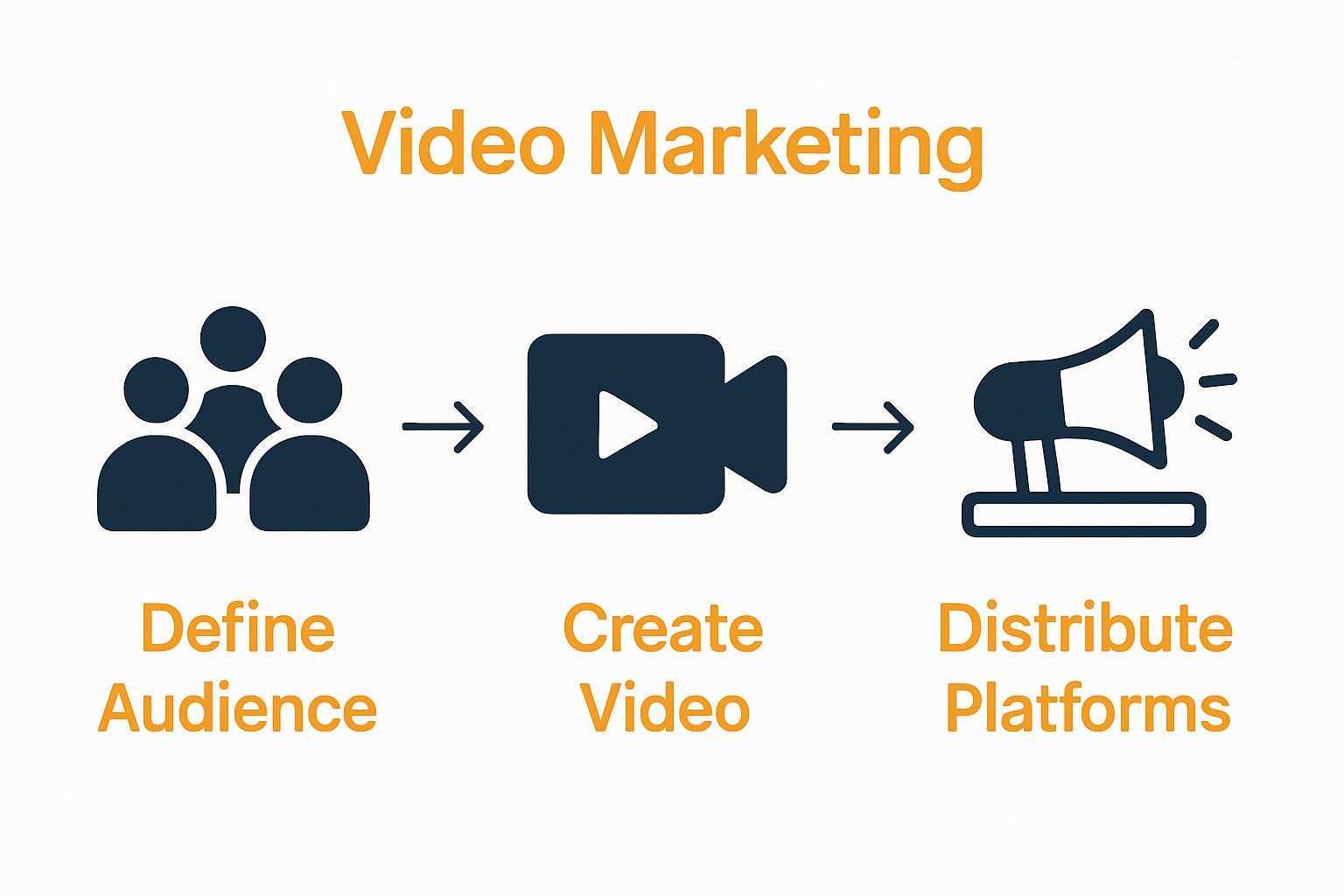How to Boost Engagement with Video in 2025
- Eddie The Chef

- Oct 13
- 9 min read

Video marketing is turning heads for businesses all across regional Australia. More than 70 percent of video content is now watched on smartphones, yet most local businesses still treat videos like digital signposts. The real secret is that a video only works when it speaks to your exact audience and solves their problems, not just when it looks flashy.
Table of Contents
Quick Summary
Key Point | Explanation |
1. Define audience and goals | Understand your target audience deeply to tailor your video strategy. |
2. Create engaging video content | Produce authentic videos that provide real value and resonate emotionally with viewers. |
3. Optimize platform distribution | Select and adapt video content for specific platforms based on audience consumption habits. |
4. Measure analytics carefully | Use analytics to gauge engagement and refine content based on viewer interactions. |
5. Test and refine your strategy | Conduct regular tests to improve video effectiveness and adapt based on audience feedback. |
Step 1: Define your target audience and goals
Successful video engagement begins with crystal clear understanding of who you want to reach and what you aim to achieve. Before filming a single frame, smart marketers invest time mapping out precise audience insights and strategic objectives.
Understanding your target audience requires deep research into demographic details, digital behaviours, and specific challenges your potential viewers experience. Start by creating comprehensive audience personas that go beyond basic age and location statistics. Consider exploring professional backgrounds, online consumption habits, preferred content formats, and the specific problems your video might solve.
For regional Australian businesses, this means diving into nuanced community characteristics. A veterinary clinic in Gippsland will have dramatically different audience needs compared to a finance professional in Melbourne. Your video strategy must reflect these unique contextual variations.
When establishing goals, think strategically about measurable outcomes. Are you seeking brand awareness, lead generation, educational outreach, or direct sales conversions? Each objective demands a tailored video approach. For instance, a trade business might prioritise demonstrating technical expertise, while a hospitality venue could focus on creating emotional connections through storytelling.
Key verification criteria for successfully completing this foundational step include:
Developing 2-3 detailed audience personas with specific characteristics
Documenting clear, measurable video marketing objectives
Identifying primary pain points your target audience experiences
Mapping potential video content types that align with audience preferences
By meticulously defining your target audience and goals, you create a robust blueprint that transforms random video production into purposeful, high-impact communication.
Below is a checklist table outlining verification criteria for successfully defining your target audience and goals in your video marketing strategy.
Verification Criteria | Description |
Detailed Audience Personas | Create 2-3 clear personas with specific characteristics relevant to your target viewers. |
Measurable Objectives | Set clear goals such as brand awareness, lead generation, education, or sales conversions. |
Audience Pain Points | Identify and document key problems or challenges your audience faces. |
Aligned Video Content Types | Map out content formats that best fit your audience preferences and business objectives. |

This strategic approach ensures every piece of video content resonates deeply and drives meaningful engagement.
Step 2: Create engaging video content tailored to your audience
Transforming audience insights into compelling video content requires strategic creativity and precise execution. Video creation is more than just recording footage it is about crafting a narrative that speaks directly to your viewers’ hearts and minds.
Your video content must transcend generic communication and become a personalised conversation with your target audience. Regional Australian businesses have unique storytelling opportunities that can differentiate them from larger, impersonal competitors. For instance, a local veterinary clinic could create authentic behind-the-scenes videos showcasing their genuine care for animals, or a Gippsland trades business might produce technical demonstrations that highlight their practical expertise.
Consider exploring multiple video formats that match audience preferences. Short form videos work brilliantly for social media platforms, while longer educational content might suit professional services like accounting or finance. Learn more about video marketing strategies that can transform your digital presence.
When developing content, prioritise authenticity and solving real customer problems. Your videos should answer specific questions, address common challenges, or provide valuable insights that demonstrate your professional understanding. A beauty wellness centre might create tutorial videos explaining skincare techniques, while a hospitality venue could showcase their unique dining experience through immersive storytelling.
Verification criteria for successful video content creation include:
Producing videos that directly address identified audience personas
Ensuring technical video quality meets professional standards
Creating content that provides clear value or solves a specific problem
Maintaining a consistent brand voice across all video productions
Remember that engagement is about connection. Your videos should feel like a conversation, not a broadcast. By thoughtfully crafting content that resonates with your specific audience, you transform simple recordings into powerful communication tools that build trust and drive meaningful interactions.
Step 3: Optimize video distribution across platforms
Successful video marketing extends far beyond creation it demands strategic distribution that reaches your target audience precisely where they consume content. Platform selection is not one size fits all and requires nuanced understanding of audience digital behaviours.
Regional Australian businesses must recognise that different platforms serve unique purposes and audience segments. LinkedIn works brilliantly for professional services and B2B communications, while Instagram and TikTok excel for visually engaging content targeting younger demographics. Discover strategic video marketing approaches that can amplify your digital reach.
Consider tailoring video content specifically for each platform. A 15-second snippet might work perfectly on Instagram Stories, while a comprehensive 3-minute tutorial could be ideal for YouTube. Facebook offers robust targeting options for local businesses, allowing precise demographic and geographical content placement.
Technical optimization is equally crucial. Ensure videos are formatted correctly for each platform, with appropriate aspect ratios, subtitles, and thumbnail designs. Mobile responsiveness remains critical, given that over 70% of video content is consumed on smartphones. Your content must look impeccable across devices, from large desktop screens to compact mobile displays.
Verification criteria for effective video distribution include:
Posting content on minimum 3 relevant platforms
Creating platform specific video variations
Implementing appropriate metadata and tags
Tracking initial engagement metrics
Remember that distribution is an ongoing process of testing, measuring, and refining. What works brilliantly on one platform might fall flat on another. Continuously monitor your analytics, adapt your strategy, and remain flexible in your approach. Successful video distribution is about understanding your audience’s digital journey and meeting them exactly where they are most receptive.
Step 4: Utilize analytics to measure engagement
Measuring video engagement goes beyond surface level metrics it requires a strategic approach to understanding audience interactions and content performance. Analytics transform raw data into actionable business insights that guide future marketing decisions.
Explore our social media management strategies to complement your video analytics approach. Understanding key performance indicators helps regional Australian businesses refine their video marketing strategies with precision. Each platform offers unique analytical tools that reveal deeper insights into viewer behaviour, watch time, audience demographics, and interaction patterns.
Professional video analytics should focus on critical metrics like view duration, audience retention rates, click through rates, and conversion potential. A veterinary clinic might track how many viewers schedule appointments after watching an educational video, while a trades business could measure how demonstration videos translate into service inquiries.
Implementing robust tracking requires connecting multiple data sources. Google Analytics, native platform insights from YouTube and Facebook, and specialised video tracking tools provide comprehensive perspectives. Pay attention to audience drop off points these moments reveal exactly where your content might be losing viewer interest.
Verification criteria for effective analytics implementation include:
Setting up comprehensive tracking across all video distribution platforms
Establishing baseline performance metrics
Creating a regular review process for video performance
Identifying specific improvement opportunities based on data insights
Remember that analytics are not just numbers they represent real human interactions with your content. By treating these metrics as conversations rather than cold statistics, you can continuously evolve your video strategy to create more meaningful connections with your target audience. Consistent measurement and adaptive approaches transform good video content into exceptional audience engagement.

Step 5: Test and refine your video strategy
Constant evolution is the heartbeat of effective video marketing. Successful strategies are never static they are living, breathing approaches that adapt and transform based on real world performance insights. Explore our comprehensive video marketing checklist to support your refinement process.
Testing requires a systematic approach that goes beyond gut feelings. Regional Australian businesses must develop a structured method for evaluating video performance. This means creating controlled experiments where you change single variables like video length, thumbnail design, opening hook, or call to action to understand precise audience responses.
Consider implementing A/B testing across different platforms. A hospitality venue might create two versions of a promotional video one highlighting menu items, another focusing on ambience and see which generates more bookings. A trades business could test technical versus storytelling approaches to determine which resonates more strongly with potential clients.
Small strategic changes can have significant impacts on audience engagement. Micro adjustments often yield macro results. Analyse viewer drop off points, experiment with different video lengths, and pay attention to audience comments and feedback.
Verification criteria for effective strategy refinement include:
Conducting minimum 3 structured video performance tests
Documenting specific changes and their measurable impacts
Developing a quarterly review process for video content
Creating a flexible adaptation framework
Remember that refinement is not about chasing perfection but maintaining continuous improvement. Your video marketing strategy should be a living document that evolves with your audience, technology, and business goals. Embrace experimentation, stay curious, and remain committed to understanding what truly connects with your viewers.
Ready to Turn Your Video Engagement Strategy Into Action?
Struggling to stand out in the noisy digital landscape is a real challenge for regional Australian businesses. If identifying your ideal audience, creating videos that convert, or optimising for different platforms has you feeling stuck, you are not alone. The article above highlighted the need for authentic storytelling, clear audience targeting, and meaningful analytics to keep your video marketing on track. But without expert guidance and an adaptable approach, it is easy to get overwhelmed or waste precious resources.

At Marketing Recipes Australia, we specialise in making video engagement easy and effective for local businesses just like yours. Our kitchen-inspired team helps transform audience insights into irresistible videos and supports you with hands-on strategy across all channels. Discover how our step-by-step video marketing services or social media management expertise can deliver real results. Do not let this year slip away chasing old strategies. Reach out now and see how our personalised recipes for engagement can help your business grow in 2025.
Frequently Asked Questions
How can I identify my target audience for video content in 2025?
To identify your target audience, conduct thorough research into their demographics, online behaviours, and specific challenges. Create detailed audience personas that incorporate insights such as professional backgrounds and content preferences to guide your video creation.
What types of video formats should I use to engage my audience in 2025?
Utilise a variety of video formats tailored to your audience preferences, such as short-form videos for social media and longer tutorials for educational purposes. Experiment with at least three different formats to see which resonates best with your viewers within the first month.
How can I ensure my video content is optimized for distribution across platforms?
To optimize video distribution, tailor each video for the platforms you are using in terms of length, formatting, and audience targeting. Aim to post on at least three relevant platforms and create specific adaptations for each to maximise reach and engagement.
What key metrics should I track to measure video engagement effectively?
Focus on tracking critical metrics such as view duration, audience retention rates, and click-through rates to measure engagement. Regularly review these metrics after each video release to identify trends and make necessary adjustments within 30 days.
How can I refine my video marketing strategy based on performance data?
To refine your video marketing strategy, conduct structured tests by changing one element at a time, like video length or thumbnail design. Document the outcomes to understand what changes lead to positive engagement within a logical testing window of three video cycles.
What should I do if my video content is not performing well?
If your video content is underperforming, analyse viewer drop-off points to identify where interest wanes.
The following troubleshooting table summarises common reasons why video content underperforms and practical solutions based on the article’s content.
Problem | Likely Cause | Recommended Solution |
Low viewer engagement | Content not tailored to audience personas | Refine personas and personalise messaging |
High audience drop-off rates | Video fails to address viewer problems or interests | Focus on solving real problems and providing value |
Limited platform reach | Videos not optimised for multiple channels | Adapt content length and format for each platform |
Inconsistent brand voice | Irregular style or tone across videos | Maintain a consistent and authentic brand presence |
Poor conversion after watching | Weak call to action or unclear objectives | Clarify objectives and strengthen video CTAs |
Technical video issues | Low quality production or improper formatting | Ensure professional quality and platform compatibility |
Adjust elements like content type or storytelling approach and re-release within 60 days to improve audience connection. |
Recommended
Comments